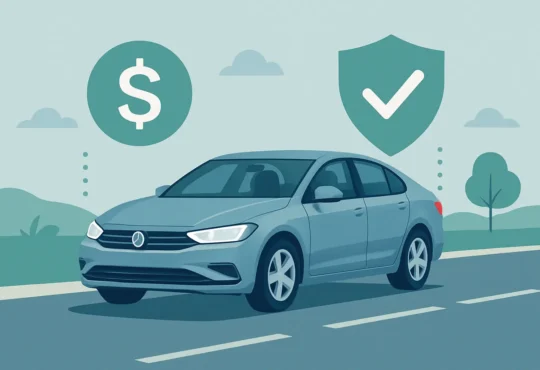Shopping for car insurance can feel overwhelming with dozens of companies, coverage options, and pricing factors to consider. However, knowing how to shop for car insurance effectively can save you hundreds or even thousands of dollars annually while ensuring you get the protection you need.
According to recent studies, drivers could be paying more than $1,000 annually on insurance coverage than necessary simply by not shopping around effectively. In this comprehensive guide, we’ll walk you through the essential steps to find the best car insurance for your needs and budget.
Why Shopping for Car Insurance Matters
Car insurance rates can vary widely between providers, and your current insurer may not always offer the best deal. The insurance landscape constantly changes, with companies adjusting their rates based on various factors including claims data, market conditions, and business strategies.
The Financial Impact of Shopping Around
Potential Savings:
- Average savings of 15-25% when switching insurers
- Some drivers save $500-$1,000+ annually by comparing quotes
- Bundling discounts can provide additional 10-25% savings
- Loyalty doesn’t always pay – rates often increase over time with the same insurer
Market Competition Benefits:
- Over 100 insurance companies compete for your business
- Different companies excel in different customer segments
- Technology improvements have made comparison shopping easier
- Online tools provide instant quotes and comparisons
When to Shop for Car Insurance
Understanding the optimal timing for shopping car insurance can maximize your savings and ensure you’re getting the best rates.
Annual Shopping Schedule
Best Times to Shop:
- 30-60 days before your policy renewal
- After major life changes (marriage, moving, new job)
- When your credit score improves significantly
- After completing defensive driving courses
- When adding or removing vehicles or drivers
Policy Renewal Considerations:
- Review your current coverage and needs annually
- Compare your renewal rate to new customer offers
- Consider whether your current coverage still fits your situation
- Evaluate any changes in your driving record or circumstances
For detailed strategies on timing your insurance shopping, reference our guide on how to shop car insurance quotes for optimal results.
Step-by-Step Guide: How to Shop for Car Insurance
Step 1: Assess Your Current Coverage and Needs
Review Your Current Policy:
- Understand your current coverage limits and deductibles
- Identify any coverage gaps or unnecessary add-ons
- Calculate your total annual premium including all discounts
- Note your current insurer’s customer service and claims experience
Evaluate Your Insurance Needs:
- Consider your vehicle’s age, value, and financing requirements
- Assess your financial ability to handle different deductible amounts
- Review state minimum requirements vs. recommended coverage levels
- Factor in your driving habits, commute distance, and risk tolerance
Life Changes Assessment:
- Marriage or divorce affecting coverage needs
- New teen drivers requiring coverage
- Vehicle purchases, sales, or modifications
- Address changes affecting rates and coverage requirements
Step 2: Gather Necessary Information
Personal Information:
- Driver’s license numbers for all covered drivers
- Social Security numbers for credit checks and identity verification
- Current addresses and how long you’ve lived there
- Employment information and education levels
Vehicle Information:
- Year, make, model, and VIN for all vehicles
- Annual mileage estimates for each vehicle
- Safety features, anti-theft devices, and modifications
- Garage or parking situation (covered vs. street parking)
Driving History:
- Driving records for all covered drivers for the past 3-5 years
- Any recent accidents, claims, or traffic violations
- Defensive driving course completions or safety certifications
- Previous insurance coverage details and claims history
Financial Information:
- Current insurance premium and payment preferences
- Budget considerations for deductibles and premiums
- Credit score information (some states allow credit-based pricing)
- Existing policies that might qualify for bundling discounts
Step 3: Understand Coverage Types and Options
Essential Coverage Types:
Liability Coverage:
- Bodily injury liability: Covers medical expenses and legal costs if you injure someone
- Property damage liability: Pays for damage you cause to others’ property
- State minimums vs. recommended coverage amounts
Physical Damage Coverage:
- Collision coverage: Repairs your vehicle after accidents
- Comprehensive coverage: Protects against theft, vandalism, weather damage
- Deductible options and how they affect premiums
Additional Protection Options:
- Uninsured/underinsured motorist coverage
- Medical payments or personal injury protection (PIP)
- Gap insurance for financed or leased vehicles
- Rental reimbursement and roadside assistance
Step 4: Compare Multiple Insurance Quotes
Quote Comparison Strategy: Compare quotes side-by-side to save time. Make sure it’s apples to apples—same coverage, same limits to ensure accurate comparisons.
Minimum Number of Quotes:
- Get at least 3-5 quotes from different types of insurers
- Include direct insurers, captive agents, and independent agents
- Consider both national carriers and regional companies
- Mix traditional insurers with newer online-only companies
Quote Comparison Tools:
- Online comparison websites for initial screening
- Individual company websites for detailed quotes
- Insurance agent consultations for personalized advice
- Mobile apps for quick quotes and policy management
Information to Compare:
- Total annual premium and monthly payment options
- Coverage limits and deductibles for each type
- Available discounts and qualification requirements
- Customer service ratings and claims satisfaction scores
- Financial stability ratings from AM Best and other agencies
For comprehensive guidance on comparing multiple quotes effectively, check out our resource on free auto insurance comparison quotes.
Step 5: Evaluate Insurance Companies
Financial Stability: Research insurer financial ratings from AM Best, Standard & Poor’s, and Moody’s to ensure they can pay claims.
Customer Service Quality:
- J.D. Power customer satisfaction studies
- State insurance department complaint ratios
- Online reviews and customer testimonials
- Claims processing speed and satisfaction ratings
Digital Capabilities:
- Mobile app functionality and user reviews
- Online policy management features
- Digital claims filing and tracking capabilities
- 24/7 customer service availability
Network and Services:
- Preferred repair shop networks and quality
- Roadside assistance coverage and response times
- Local agent availability if preferred
- Additional services like accident forgiveness or new car replacement
Common Car Insurance Shopping Mistakes to Avoid
Mistake 1: Focusing Only on Price
While cost is important, the cheapest policy isn’t always the best value. Consider coverage quality, customer service, and claims handling reputation alongside price.
Mistake 2: Not Comparing Equivalent Coverage
Simple car insurance mistakes can cost you thousands. Ensure you’re comparing identical coverage limits, deductibles, and policy features across different insurers.
Mistake 3: Overlooking Available Discounts
Common Discount Opportunities:
- Multi-policy bundling (auto + home insurance)
- Safe driver and good student discounts
- Anti-theft and safety feature discounts
- Professional organization and employer discounts
- Low mileage and usage-based insurance programs
Mistake 4: Ignoring Customer Service Quality
Research customer service ratings and claims handling reputation. Poor service can make dealing with claims stressful and time-consuming.
Mistake 5: Not Updating Coverage Regularly
Review your coverage annually to ensure it still meets your needs. Life changes, vehicle values, and financial situations evolve over time.
For more detailed information on avoiding costly mistakes, explore our article on 7 tips to get discount car insurance quotes.
Top Car Insurance Companies to Consider
GEICO
GEICO is known for competitive rates and strong digital tools, making it popular among cost-conscious drivers.
GEICO Advantages:
- Typically competitive pricing
- Excellent mobile app and online tools
- 24/7 customer service
- Wide range of discount options
- Strong financial stability
State Farm
State Farm offers comprehensive coverage options with the largest agent network in the United States.
State Farm Benefits:
- Extensive local agent network
- Strong customer service reputation
- Comprehensive coverage options
- Good student and safe driver programs
- Bundling opportunities with home insurance
Progressive
Progressive is known for innovative features like usage-based insurance and comprehensive online tools.
Progressive Features:
- Name Your Price tool for budget-conscious shoppers
- Snapshot usage-based insurance program
- Gap coverage and custom parts/equipment coverage
- 24/7 claims service
- Competitive rates for high-risk drivers
Allstate
Allstate offers various coverage options and unique features like accident forgiveness and new car replacement.
Allstate Advantages:
- Accident forgiveness programs
- New car replacement coverage
- Comprehensive local agent support
- Strong financial ratings
- Drivewise usage-based insurance program
USAA (Military Members Only)
USAA consistently ranks highest in customer satisfaction among insurers serving military members and their families.
USAA Benefits:
- Excellent customer service ratings
- Military-specific benefits and understanding
- Competitive rates for eligible members
- Comprehensive financial services integration
- Specialized coverage for military needs
For detailed comparisons between major insurers, check out our analysis of State Farm vs GEICO and Progressive vs Allstate.
Money-Saving Tips When Shopping for Car Insurance
1. Bundle Your Policies
Combining auto and home insurance can save 10-25% on both policies. Many insurers offer significant multi-policy discounts.
2. Choose Higher Deductibles
Increasing your deductible from $250 to $1,000 can reduce collision and comprehensive premiums by 15-30%.
3. Maintain Good Credit
In states where it’s allowed, good credit can significantly reduce your insurance rates. Pay bills on time and monitor your credit score regularly.
4. Take Advantage of Low Mileage Discounts
If you drive less than 7,500 miles annually, you may qualify for low mileage discounts with many insurers.
5. Consider Usage-Based Insurance
Programs that monitor your driving habits can provide discounts of 10-30% for safe drivers.
6. Maintain Continuous Coverage
Avoiding lapses in coverage helps you qualify for better rates and avoid high-risk categorization.
Understanding Car Insurance Discounts
Safe Driving Discounts
- Clean driving record discounts (no accidents or violations)
- Defensive driving course completion
- Usage-based insurance program participation
- Accident-free periods and claim-free discounts
Vehicle-Related Discounts
- Anti-theft device and security system discounts
- Safety feature discounts (airbags, ABS, electronic stability control)
- Multi-vehicle discounts for insuring multiple cars
- New vehicle and hybrid/electric vehicle discounts
Personal and Lifestyle Discounts
- Good student discounts for students with high GPAs
- Professional organization and employer group discounts
- Military and federal employee discounts
- Senior citizen and mature driver discounts
Policy and Payment Discounts
- Multi-policy bundling discounts
- Auto-pay and paperless billing discounts
- Early signing and advance payment discounts
- Loyalty discounts for long-term customers
Special Considerations for Different Drivers
Young Drivers
Strategies for Teen and Young Adult Drivers:
- Add teens to parent policies rather than separate coverage
- Look for good student discounts and driver training programs
- Consider usage-based insurance to reward safe driving
- Compare companies that specialize in high-risk or young drivers
Senior Drivers
Considerations for Older Drivers:
- Mature driver discounts and defensive driving course benefits
- Evaluate coverage needs as vehicle values decrease
- Consider medical payment coverage enhancements
- Look for insurers with senior-friendly customer service
High-Risk Drivers
Options for Drivers with Violations or Claims:
- Compare specialized high-risk insurers
- Consider non-standard insurance markets
- Focus on improving driving record over time
- Evaluate state-assigned risk pools if necessary
Digital Tools and Technology in Car Insurance Shopping
Mobile Apps and Online Tools
Modern insurance shopping increasingly relies on digital tools:
- Mobile quote comparison apps
- Usage-based insurance monitoring programs
- Digital policy management and claims filing
- AI-powered recommendation engines
Telematics and Usage-Based Insurance
How Technology Affects Rates:
- Smartphone apps that monitor driving behavior
- Plug-in devices that track mileage and driving patterns
- Potential savings of 10-30% for safe drivers
- Real-time feedback to improve driving habits
Online Comparison Platforms
Benefits and Limitations:
- Quick initial screening of multiple insurers
- Side-by-side comparison of basic coverage options
- May not include all available discounts or options
- Should be supplemented with direct insurer quotes
According to Consumer Reports, shopping for car insurance requires understanding key factors and must-know topics to make informed choices.
State-Specific Considerations
No-Fault vs. Fault States
Understanding your state’s insurance system affects coverage needs:
- No-fault states: Require personal injury protection (PIP)
- Fault states: Allow tort lawsuits for accident damages
- Choice no-fault: Offer options between systems
State Minimum Requirements
Each state has different minimum coverage requirements:
- Liability coverage minimums vary significantly
- Some states require uninsured motorist coverage
- Medical payment or PIP requirements vary
- Proof of insurance and penalties for driving uninsured
Regional Insurance Considerations
- Urban vs. rural rate differences
- Weather-related coverage needs (flood, hail, hurricane)
- State insurance department resources and complaint processes
- Regional insurer availability and competitiveness
Making Your Final Decision
Factors to Weigh in Your Decision
Financial Considerations:
- Total annual cost including all fees
- Payment plan options and associated costs
- Deductible amounts you can comfortably afford
- Potential savings from available discounts
Service Quality Factors:
- Customer service availability and quality
- Claims handling reputation and satisfaction
- Digital tools and mobile app functionality
- Local agent availability if desired
Coverage Adequacy:
- Protection levels for your assets and income
- Coverage for specific needs and situations
- Policy flexibility for future changes
- Additional benefits and services included
Questions to Ask Before Buying
- What discounts am I eligible for that aren’t already applied?
- How will my rates change at renewal time?
- What is the claims filing and resolution process?
- Are there any coverage limitations or exclusions I should know about?
- How does the company handle rate increases and policy changes?
Conclusion
Learning how to shop for car insurance effectively is one of the most valuable financial skills you can develop. With the average driver potentially overpaying by over $1,000 annually, taking the time to shop around and compare options can result in significant savings while ensuring adequate protection.
Key Takeaways for Successful Car Insurance Shopping:
- Shop Regularly: Review and compare rates at least annually
- Compare Comprehensively: Get quotes from multiple insurers with identical coverage
- Understand Coverage: Know what you’re buying and what you actually need
- Consider Total Value: Balance price with service quality and coverage adequacy
- Take Advantage of Discounts: Maximize all available discount opportunities
- Maintain Good Credit: Your credit score significantly impacts rates in most states
- Keep Continuous Coverage: Avoid lapses that can increase future rates
Remember that the cheapest option isn’t always the best value. Focus on finding the right balance of coverage, service quality, and price for your specific situation. With proper research and comparison shopping, you can find car insurance that provides excellent protection while fitting comfortably within your budget.
The insurance market is competitive and constantly evolving, which works in your favor as a consumer. By following the strategies outlined in this guide and shopping proactively, you can ensure you’re getting the best possible value for your car insurance investment.
Car insurance requirements and rates vary by state and individual circumstances. This guide provides general information and should not be considered legal or financial advice. Always consult with licensed insurance professionals for specific coverage recommendations and current pricing information.
Thank you for visiting our website, TechsBucket. If you liked the article, then share it with others.


